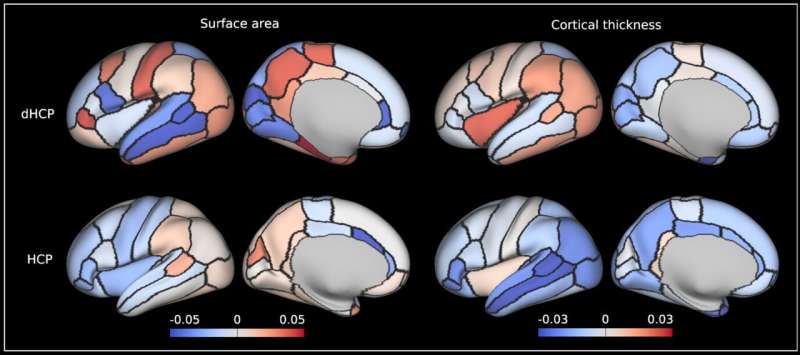Asymmetry indices of surface area and cortical thickness for the dHCP and HCP-YA cohorts, averaged (for the dHCP) within regions of the the M-CRIB-S atlas (neonatal equivalent of Desikan-Killiany atlas) (1, 2) and (for HCP-YA) the Desikan-Killiany atlas (3). Leftward asymmetry indices are color-coded red, and rightward asymmetry indices are color-coded blue. Data at https://balsa.wustl.edu/1pn1V. Credit: Nature Human Behaviour (2023). DOI: 10.1038/s41562-023-01542-8
Researchers publishing in Nature Human Behaviour, looked at how different (asymmetrical) the left and right side of babies' brains were in terms of their shape and patterns of brain activity to establish a benchmark for future studies to investigate how asymmetries relate to brain disorders.
Previous research has shown that people with and without mental health conditions have different brain asymmetries. There is a limited understanding of how asymmetric babies' brains are at birth, and since babies act differently from adults, and cannot do tasks during MRI scans, this study aimed to understand how asymmetric the brain is at birth, if at all.
For this study, the researchers investigated asymmetries in 442 healthy term-born neonate babies (newborns in the first month after birth) using MRI images that showed the function and structure of the brain, from the Developing Human Connectome Project. These differences were compared against similar patterns taken from 103 preterm neonates scanned at the same age, as well as 1,110 healthy young adults from the Human Connectome Project.
This study found the presence of many brain asymmetries in the areas responsible for language and vision tasks like face recognition. Moreover, we found that brain asymmetries in babies born early were the same as those in babies born on time. This is significant, because being born early affects nearly all other aspects of brain development except brain asymmetry, said Logan Williams, Ph.D. student from the School of Biomedical Engineering & Imaging Sciences.
He added, "Our findings suggest that brain asymmetries are hard-wired and are very important for future brain development."
The study found that neonatal babies' brains are very asymmetric and show similar patterns to adults. This finding will act as a baseline for future studies that explore brain symmetry and allow scientists to interpret studies where they are investigating changes of brain asymmetry in relation to certain health conditions.
More information: Logan Z. J. Williams et al, Structural and functional asymmetry of the neonatal cerebral cortex, Nature Human Behaviour (2023). DOI: 10.1038/s41562-023-01542-8. www.nature.com/articles/s41562-023-01542-8
Journal information: Nature Human Behaviour
Provided by King's College London
























